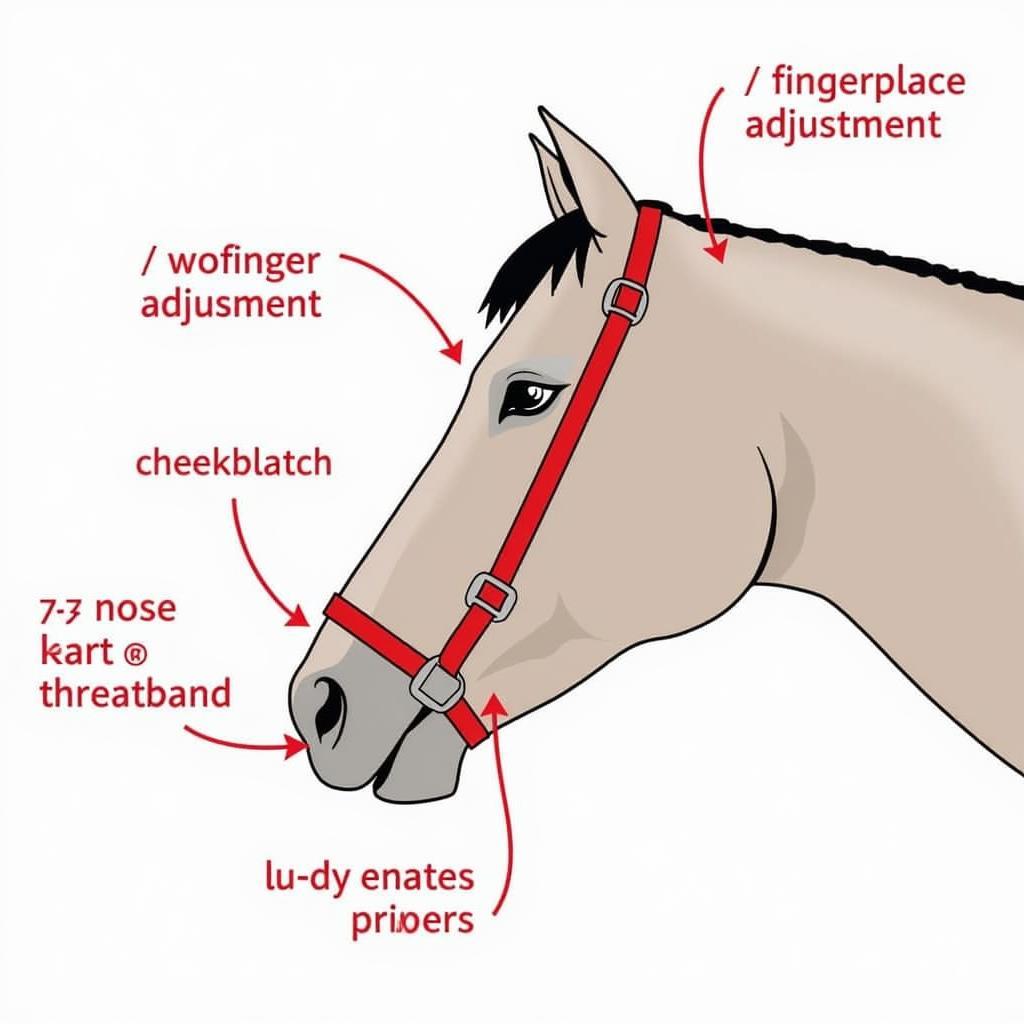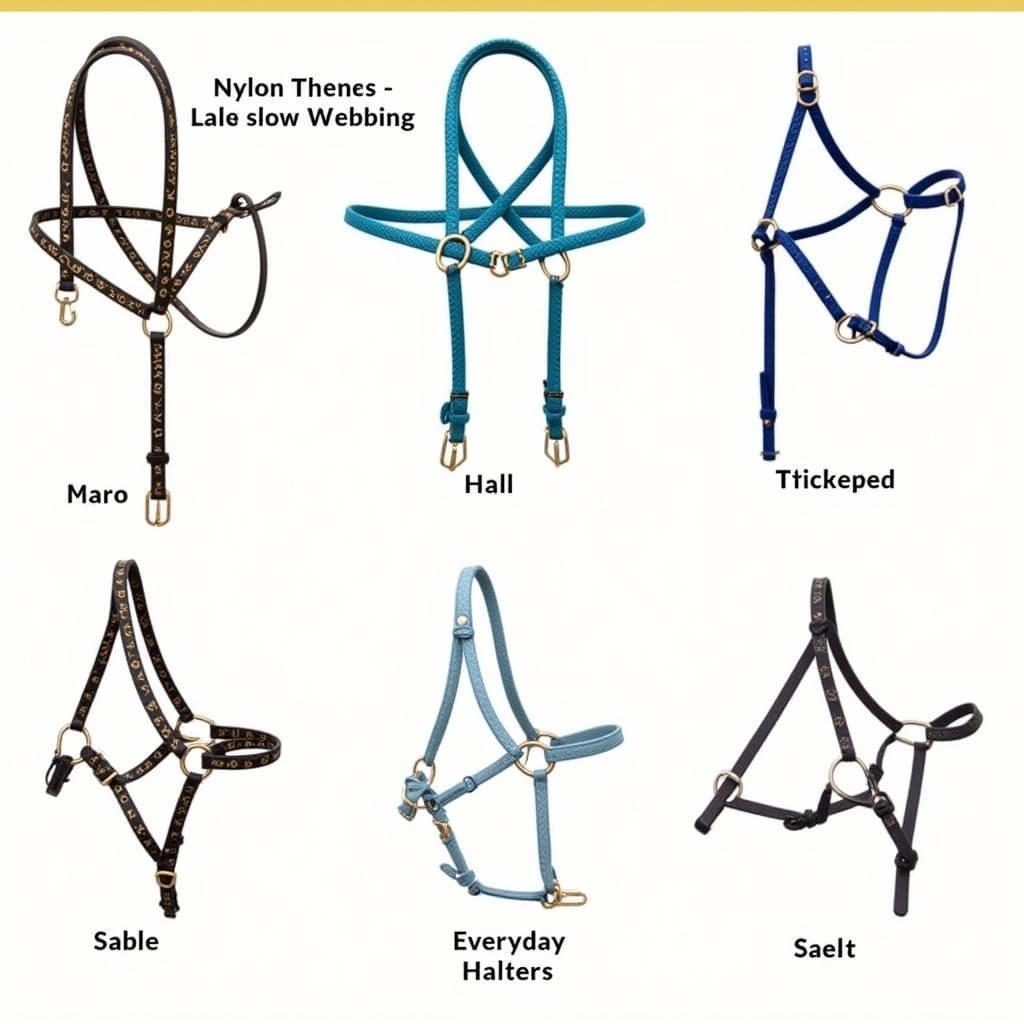Nylon Halters For Horses are a staple in every stable and tack room. These versatile pieces of equipment are essential for everyday horse handling, from leading and tying to training and turnout. Choosing the right halter can significantly impact your horse’s comfort and safety, so understanding the different types, materials, and fitting techniques is crucial.
Exploring the Versatility of Nylon Halters
Nylon halters are popular for several good reasons. They’re durable, lightweight, easy to clean, and relatively inexpensive. This makes them a practical choice for everyday use. Whether you’re leading your horse to the pasture, grooming, or working in the arena, a nylon halter is often the go-to option. But not all nylon halters are created equal. Let’s dive deeper into the world of nylon halters for horses.
Choosing the right halter involves considering several factors, including the horse’s size and age, the intended use, and the desired features. For example, a young horse just starting halter breaking will benefit from a softer, padded halter, while a seasoned show horse might require a more refined, stylish option. It’s also important to consider the hardware. Rust-resistant hardware is essential, especially if the halter will be exposed to the elements.
Just after halter breaking, you might want to look into personalized halters. You can find more information at personalised horse halter.
Sizing and Fitting Your Horse’s Nylon Halter
Proper fit is paramount for both comfort and safety. A halter that’s too loose can easily slip off, while one that’s too tight can restrict breathing and cause discomfort. When fitting a nylon halter, ensure you can comfortably fit two fingers between the halter and your horse’s cheek. The noseband should sit about two inches below the cheekbone. The crownpiece should fit snugly behind the ears without being too tight.
There are different sizes available, from miniature horse halters to those designed for draft breeds. It’s essential to measure your horse’s head correctly to ensure a perfect fit. An ill-fitting halter can cause rubbing and sores, so taking the time to get it right is essential.
 Nylon Halter Fitting Guide for Horses
Nylon Halter Fitting Guide for Horses
For owners of miniature horses, finding the right fit can be particularly challenging. Learn more about halters specifically designed for these smaller equines at halters for miniature horses.
Types of Nylon Halters for Horses
Nylon halters come in various styles, each designed for a specific purpose. Breakaway halters, for instance, are designed with a safety feature that allows them to release under pressure, preventing injury if the horse gets caught. These are particularly useful for turnout. Show halters, on the other hand, are designed for aesthetic appeal, often featuring decorative stitching or embellishments. And then there are everyday halters, which are durable and practical for daily use.
“A well-fitted halter is essential for the horse’s well-being. It’s not just about preventing escapes; it’s about ensuring the horse is comfortable and safe,” explains Dr. Emily Carter, Equine Veterinarian.
Looking for something a little different? cute horse halters may offer the perfect blend of style and practicality.
Caring for Your Nylon Halters
Maintaining your nylon halters is simple. Most can be washed with mild soap and water or even tossed in the washing machine. Regular cleaning helps prevent the buildup of dirt and grime, which can harbor bacteria and irritate the horse’s skin. Proper care will also extend the lifespan of your halter.
Beyond the Basics: Browbands and Halter Breaking
While the halter is essential, other equipment can enhance its functionality and your horse’s comfort. Browbands, for instance, add a touch of style and can help keep the halter in place. They can be plain or adorned with beads, crystals, or other embellishments.
For information on browbands, you can visit browband for horses.
Introducing a halter to a young horse is a significant step in their training. The process requires patience and understanding. For guidance on halter breaking, see our comprehensive article on halter breaking horses.
“Remember, the initial halter experience can shape a horse’s attitude towards handling for years to come. Patience and positive reinforcement are key,” advises John Miller, Certified Horse Trainer.
Conclusion: Making the Right Choice for Your Equine Companion
Choosing the right nylon halter for horses involves careful consideration of several factors. From size and fit to intended use and care, understanding these aspects will ensure your horse’s comfort and safety. Investing in a quality nylon halter is an investment in your horse’s well-being.
 Different Types of Nylon Halters for Horses
Different Types of Nylon Halters for Horses
FAQ
- How often should I clean my horse’s nylon halter?
- What are the signs of a poorly fitting nylon halter?
- Can I leave a nylon halter on my horse overnight?
- Are breakaway halters suitable for all horses?
- What is the average lifespan of a nylon halter?
- How do I measure my horse for the correct halter size?
- What are the different types of hardware used on nylon halters?
Need help? Contact us at Phone Number: 0772127271, Email: [email protected] Or visit our address: QGM2+WX2, Vị Trung, Vị Thuỷ, Hậu Giang, Việt Nam. We have a 24/7 customer service team.